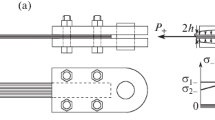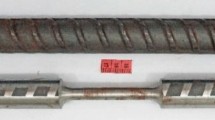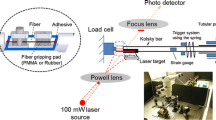Abstract
The strength of a unidirectional composite along the fibers is the most important characteristic for the design calculation of composite products, being, however, most difficult for correct determination in an experiment. The main problem is attributed to the shape and methods of fixing the specimen providing the minimum impact of the stress concentration near the grips on the strength. The impossibility of direct use of standard self-tightening grips because of lateral crushing of the specimen led to the necessity of using either specimens with glued pads or special grips with a constant transverse force. Specimens with fillets should not be used for unidirectionally reinforced plastics. When using standardized specimens in the form of rectangular strips with abruptly varying shear stresses applied to their lateral surface, which results in a significant concentration of tensile stresses, an incorrect result can be obtained. We present the calculated values of the stress concentration factor (SCF) near the grips using a simplified model of shear analysis and the finite element method (FEM). Since the strength reduction factor is always less than the theoretical stress concentration factor, a phenomenological parameter of the material with the dimension of length as a characteristic size of the stress averaging zone should be introduced to assess the strength value. Three methods are proposed to find this characteristic size according to the results of testing specimens of different kind: (1) smooth with various thicknesses; (2) smooth with various thicknesses and with holes in which the failure occurs at the hole, away from the grips; (3) with a series of holes with a decreasing radius, to find that small radius the influence of which on the decrease in strength is equivalent to the influence of grips. Proceeding from the experimentally determined characteristic size, the dependences of the strength on the specimen thickness, on the ratio of Young’s and shear modulus, on the length of the grips and the working zone, and on the degree of stress smoothing near the grip edges are calculated. The proposed calculation and experimental technique provided more accurate assess of the “true” tensile strength of the composites, which can be approximately 10% higher than that determined on the specimens of large thickness. Taking this correction for the effect of grips into account, it appeared possible to reduce the safety factor and, hence, to reduce the mass of composite structures.







Similar content being viewed by others
REFERENCES
Tarnopol’skii, Yu.M. and Kintsis, T.Ya., Metody staticheskikh ispytanii armirovannykh plastikov (Methods of Static Testing of Reinforced Plastics), Moscow: Khimiya, 1981, 3rd ed.
Alfutov, N.A., Zinov’ev, P.A., and Popov, B.G., Raschet mnogosloinykh plastin i obolochek iz komozitsionnykh materialov (Calculation of Multilayer Plates and Shells Made of Composite Materials), Moscow: Mashinostroenie, 1984.
Vasil’ev, V.V., Mekhanika konstruktsii iz komozitisonnykh materialov (Mechanics of Constructions from Composite Materials), Moscow: Mashinostroenie, 1988.
Kerber, M.L., Polimernye kompozitsionnye materialy: struktura, svoistva, tekhnologiya (Polymer Composite Materials: Structure, Properties, and Technology), St. Petersburg: Professiya, 2008.
Polilov, A.N., Eksperimental’naya mekhanika kompozitov (Experimental Mechanics of Composites), Moscow: Mosk. Gos. Tekh. Univ. im. N.E. Baumana, 2015.
Pagano, F., Paulmier, P., Kaminski, M., and Thionnet, A., Numerical and experimental approach for improving quasi-static and fatigue testing of a unidirectional CFRP composite laminate, Procedia Eng., 2018, vol. 213, pp. 804–815. https://doi.org/10.1016/j.proeng.2018.02.076
Shokrieh, M.M. and Omidi, M.J., Tension behavior of unidirectional glass/epoxy composites under different strain rates, Compos. Struct., 2009, vol. 88, no. 4, pp. 595–601.
Czél, G., Jalalvand, M., and Wisnom, M.R., Hybrid specimens eliminating stress concentrations in tensile and compressive testing of unidirectional composites, Composites, Part A, 2016, vol. 91, pp. 436–447. https://doi.org/10.1016/j.compositesa.2016.07.021
Oleinikov, A.I., Estimation of the static strength of layered composites, Uch. Zap. Tsentr. Aerogidrodin. Inst., 2019, vol. 50, no. 4, pp. 53–66.
Mel’nikov, D.A., Il’ichev, A.V., and Vavilova, M.I., Comparison of standards for mechanical compression testing of fiberglass, Tr. Vseross. Inst. Aviats. Mater., 2017, no. 3 (51), p. 6.
Babushkin, A.V., Vil’deman, V.E., and Lobanov, D.S., Tensile tests of unidirectional highly filled fiberglass at normal and elevated temperatures, Zavod. Lab., Diagn. Mater., 2010, vol. 76, no. 7, pp. 57–59.
Tikhonov, V.B., Blaznov, A.N., and Savin, V.F., Method of fiberglass testing for static durability, Inorg. Mater., 2011, vol. 47, no. 15, pp. 1702–1706.
Lebrun, G., Couture, A., and Laperrière, L., Tensile and impregnation behavior of unidirectional hemp/paper/epoxy and flax/paper/epoxy composites, Compos. Struct., 2013, vol. 103, pp. 151–160. https://doi.org/10.1016/j.compstruct.2013.04.028
Smerdov, A.A. and Tairova, L.P., Identification of the elasticity and strength characteristics of a unidirectional layer of multilayer carbon plastics–implementation features in the study of the influence of nanoparticles, Konstr. Kompoz. Mater., 2015, no. 2 (138), pp. 52–58.
Komarov, V.A., Kishov, E.A., Charkviani, R.V., and Pavlov, A.A., Calculation and experimental analysis of the strength of products from fabric epoxy carbon fiber, Vestn. Samar. Gos. Aerokosm. Univ. im. Akad. S.P. Koroleva, 2015, vol. 14, no. 2, pp. 106–112.
Kosheleva, N.A., Shipunov, G.S., Voronkov, A.A., Merkusheva, N.P., and Tikhonova, A.A., Experimental studies to determine the deformation of polymer composite specimens using fiber optic sensors, Vestn. Perm. Nats. Issled. Politekh. Univ., Aerokosm. Tekhn., 2017, no. 50, pp. 26–35.
Kiryushina, V.V., Kovaleva, Yu.Yu., Stepanov, P.A., and Kovalenko, P.V., Investigation of the influence of the scale factor on the strength properties of polymer composite materials, Izv. Vyssh. Uchebn. Zaved., Yad. Energ., 2019, no. 1, pp. 97–106.
Kroupa, T., Zemèík, H., and Zemèík, R., Micromechanical analysis of fiber spatial distribution influence in unidirectional composite cross-section on overall response in terms of tensile curves, Mater. Today: Proc., 2019, vol. 12, pp. 395–403. https://doi.org/10.1016/j.matpr.2019.03.141
Polilov, A.N., Mechanisms of stress concentration reduction in fiber composites, J. Appl. Mech. Tech. Phys., 2014, vol. 55, no. 1, pp. 154–163.
Polilov, A.N., Etyudy po mekhanike kompozitov (Etudes on Composite Mechanics), Moscow: Fizmatlit, 2015.
Funding
This work was supported by the Russian Foundation for Basic Research, grant no. 18-08-00372.
Author information
Authors and Affiliations
Corresponding author
Additional information
Translated by Sh. Galyaltdinov
Rights and permissions
About this article
Cite this article
Polilov, A.N., Arutyunova, A.S. & Tatus’, N.A. Effect of Stress Concentration near Grips on the Tensile Strength of Composites. Inorg Mater 57, 1555–1564 (2021). https://doi.org/10.1134/S0020168521150164
Received:
Revised:
Accepted:
Published:
Issue Date:
DOI: https://doi.org/10.1134/S0020168521150164
Keywords:
- fiber reinforced plastic (FRP)
- unidirectional carbon fiber reinforced plastic (CFRP)
- unidirectional glass fiber reinforced plastic (GFRP)
- tensile test
- theoretical stress concentration factor
- stress concentration near the grips
- strength reduction factor
- effective stress concentration factor
- specimen with a hole
- finite element method (FEM)




